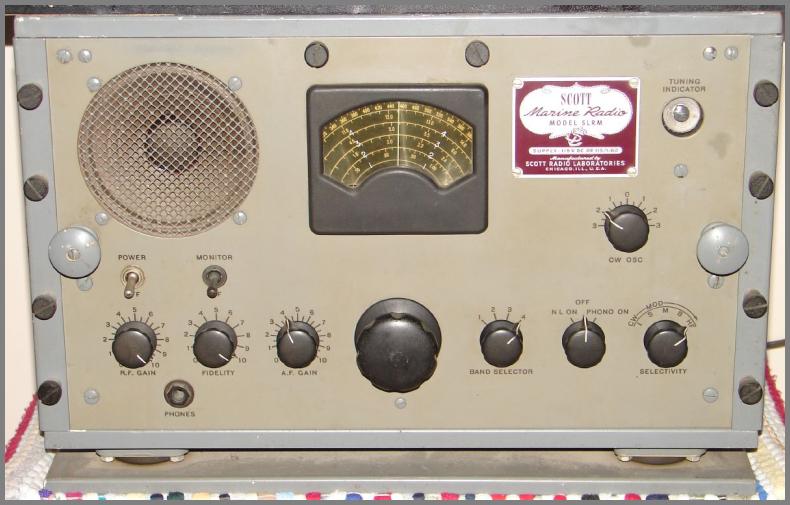I have a functioning Scott SLRM Marine radio in great shape. The only problem is that when the set is tuned to a reasonably strong MW/AM Broadcast station there is a kind of 'rumble' over the signal; it's difficult to describe...not 'scratchy' like an intermittent loose wire but kind of a bass geiger-counter type sound (continuous bumps and rumbles in a non-periodic sequence). I've looked for loose wires, cleaned the band-switch, tuner condenser etc; the tubes all test fine.
Any hints/intuitions/gut feelings on how to solve this problem would be appreciated. A duff capacitor somewhere?
Cheers, and thanks as always.
Leslie
Cheers,
Leslie
Thats going to typically be an answering and isolating of, if its a variation of the AVC line biasing or a power supply problem.
|
:I should also add that I cannot remove the audio 'rumble' by adjusting the Audio Gain, Quality (Tone), RF Gain or Sensitivity switches. The rumble is also not present between stations--only when a fairly strong signal is being received.
:
:Cheers,
:Leslie
:
Nice to hear from you again. I have the SLRM manual and schematics, and I'll look for the units you mention. I have located C156 under the chassis, and I am assuming (correctly?) that the 156-A and 156-B are in the same can. Would it be a useful idea to replace C156?
The Scott radio very helpfully has various capacitors labelled underneath the chassis, but I cannot find C144; can you tell me what section it is in? When I find that one, I guess I'll see R121 close by/attached to it.
I'll look for the C148.
I'll let you know.
Cheers and many thanks,
Leslie
:
:Nice to hear from you again. I have the SLRM manual and schematics, and I'll look for the units you mention. I have located C156 under the chassis, and I am assuming (correctly?) that the 156-A and 156-B are in the same can. Would it be a useful idea to replace C156?
:
:The Scott radio very helpfully has various capacitors labelled underneath the chassis, but I cannot find C144; can you tell me what section it is in? When I find that one, I guess I'll see R121 close by/attached to it.
:
:I'll look for the C148.
:
:I'll let you know.
:
:Cheers and many thanks,
:
:Leslie
:
:
:
Parte deux . . . . Correct . . . . your electrolytic C156 IS a dual unit . . . . . wouldn't worry about it just yet, as I feel that if we are having a marginal On that 'ole thang, I would expect the C141 to be a metallic "bathtub" design of capacitor with at least one other "A"section also
|
Thanks for the homework, which I've diligently undertaken in my workshop. What I will say is that this Scott set is probably the best radio I've ever dealt with in terms of build quality (like a tank) and ease of finding parts (Resistors, Capacitors, Transformers being helpfully labelled).
As to the detail of the audio 'rumble' (a mild 'motorboating' perhaps?) I've tried the following, but without success:
i) I've replaced (temporarily), C148, and C156.
ii) I've tried to clean the AF switch, but it's actually impossible to get any cleaning solution inside; the switches appear to be covered with something similar to the 'tropical use' shellac used on a number of WW2 radios I've encountered. Anyhow, it's sealed shut. When I adjust the volume, it makes no difference to the 'ticking' (just makes it louder, but does not alter the speed or sequence of the noises.
iii) I found R121 (helpfully labelled on a bakelite board along with several others), and tried grounding as suggested. The audio signal disappeared and the dial light became brighter, showing a short to ground I guess.
Further indications:
i) the ticking starts to occur after the set begins to warm up. The station audio is heard, and then the ticking begins after about 20-30 seconds.
ii) the sound is less obvious on weaker signals. The more powerful the station, the more intrusive the noise.
Head Scratching:
i) Do you think this could be caused by a 'noisy tube'; one which tests OK (they all do), but has a fault which isn't shown on my tester. As someone used to say to me, 'your radio is your tube tester'...
ii) If it could be a tube with a short, which would be the likely villain? V107 (for example)?
iii) I've turned my eyes inside out looking for any loose wires, though the 'ticking' doesn't sound like that, and no moving the set around will change the nature of the 'ripple'.
iv) would there be any sense in changing out all the electrolytics just in case? I'll reconnect C148 and C156 as they seem to fine and 'if it ain't broke, don't fix it'.
Thanks for all your help, Sir Edd, and I hope I can get to the bottom of this gremlin before the Scott is put to gather dust at the back of my workshop as one of those sets requiring an exorcism...
Cheers,
Leslie


